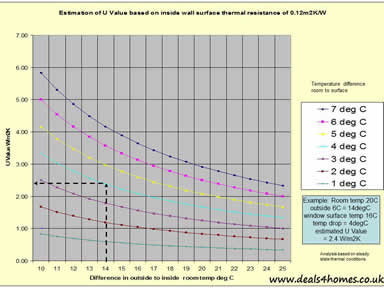Take three temperatures:
All temperatures to be measured on centigrade scale.
Make sure the room is in a stable heat state as possible that is the heating has been consistent for several hours and outside temperature is not fluctuating.
Measure;
- Outside temperature
- Inside Room temperature
- Surface temperature
Equipment required; Contact or Inferred thermal thermometer. Weather station or thermometer that will measure air temperature.
- Calculate the difference in room temperature and outside temperature and then draw a vertical line on the chart to the corresponding temperature.
- Calculate the difference in room temperature and the wall or window surface temperature and draw a horizontal line where it passes the curved line. (Note: for decimals interpolate between curves). Then read off the left hand side of the chart the estimated ‘U’ value.

Download pdf version of this chart
Note; This method of determining a ‘U’ value under site conditions is approximate and dependant on the accuracy of the measurements and quality of the measuring equipment but never the less can give a good indication how a material is performing.
Best results are achieved at night where conditions are more stable and there is a greater difference between inside and outside temperatures.